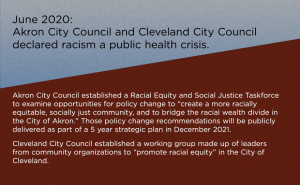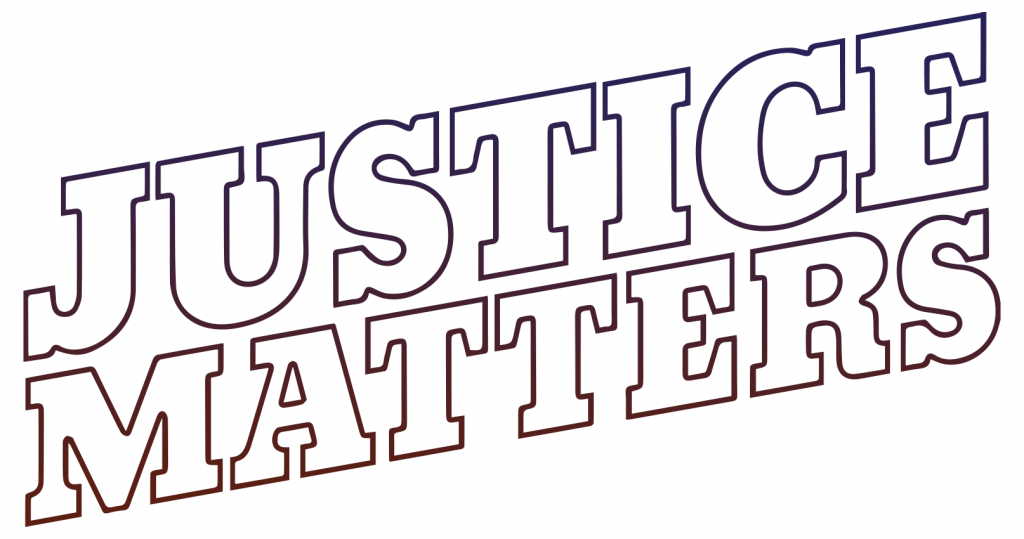
A Year In Review: After Countless Cries For Racial Justice, Where Are We Now?
By: Sara Crawford | Maria McGinnis | The Collaborative News Lab @ Kent State University, Sarah Taylor | WKSU
Posted on:
KENT, Ohio (WKSU) — Last year, streets throughout the U.S. were full of people protesting racial injustices that have tormented the country for years, demanding real change. Since then, task forces, declarations, criminal charges and acts of solidarity have been the result. Despite the efforts of government officials and protesters, the question, “Has anything changed?” still begs an answer.
Systemic racism and police brutality agonized the Black community well before the deaths of Ahmaud Arbery, Breonna Taylor and George Floyd, but the murder of Floyd in May 2020 helped create the “perfect storm” leading thousands to protest for change.
From Minneapolis, the site of Floyd’s killing, protests began erupting across the world, including in Northeast Ohio.

There have been more than 4,700 demonstrations across the country in approximately 2,500 small towns and big cities, according to an article from the New York Times. In Ohio, more than 400 demonstrations were documented.
WORKING TOWARD CHANGE IN OHIO
Citizens across the nation are asking for elected officials to change the approach to public safety and policing. Northeast Ohio is no exception.
In Akron’s Racial Equity and Social Justice Task Force’s recommendations, police training has been discussed in terms of how new and experienced police officers are trained.
“The working group and the [criminal justice] subcommittee as a whole have been especially interested in implicit bias, cultural competence and de-escalation training,” the Quarter 2 report states. Full recommendations can be expected in the end of the year report.
Long before Floyd’s death, Cleveland officials were forced to face questions about policing following the shooting deaths of Timothy Russell and Malissa Williams by Cleveland police in 2012. The concerns lingered in 2020’s social justice reckoning.
“That was the watershed moment that invoked Mayor Frank Jackson to ask the U.S. Department of Justice to come in and examine the police department for potential violations of constitutional rights and abuse of force, and they found those violations,” said Wendy Patton, senior project director at Policy Matters Ohio. “Today, the Cleveland Police Department is monitored for 255 provisions which need improvement and need to meet recommendations.”
The 255 provisions are a part of the Department of Justice’s consent decree, which started in 2015. The decree states: “… the City of Cleveland is committed to ensuring that police services in Cleveland are delivered in a manner that is constitutional, effective and consistent with community values, while preserving officer and public safety.”
Over the past six years, the Cleveland Police Department has met operational or general compliance on 37% of the provisions. Most provisions have had at least partial compliance. Evaluations on the rest have been deferred by the monitoring team. However, Patton noted that police from surrounding areas, who may be called upon to join Cleveland police in cases of emergency, aren’t bound by the consent decree’s expectations.
Patton acknowledges social factors, including racism, in her report about the Cleveland Police Department: “For years, cities including Cleveland, relied heavily on police, without addressing the root causes of crime and violence.”
RACISM A PUBLIC HEALTH CRISIS
In response to the public outcry for justice, many Ohio city and county councils declared racism a public health crisis. The Cleveland City Council was the first city in Northeast Ohio to pass such a resolution. Declaring racism a public health crisis is the first step in acknowledging that racism exists, specifically addressing its effects on public health, according to reporting from CNN.

“Now that we understand that we have this public-health crisis, we have to do something about it,” said Cleveland City Councilman and Majority Leader Blaine Griffin during the council meeting in which the resolution was passed. “Whatever we do, we have to make sure that the citizens of this city touch, feel, hear and see real change.”
However, the act of declaring racism a public health crisis may not be enough on its own to bring about substantial change.
“It is just a hollow gesture because some of the same folks that were a part of declaring racism a public health crisis are the same folks that are for the implementation of the very things that trouble our community, that are instruments of racism,” said Kareem Henton, a community organizer for Black Lives Matter Cleveland.
Following these declarations, task forces emerged to focus on researching and working to improve the racial disparities in the communities they serve.
- Cleveland Heights Racial Justice Task Force
- Akron’s Racial Equity and Social Justice Task Force (RESJ)
- Summit County’s Special Reviews Committee
- Cuyahoga County’s Citizens Advisory Council on Equity
- The COVID-19 Ohio Minority Health Strike Force
The groups all tout different names but were all created to serve the same purpose in their jurisdictions. Each of these task forces follows a similar model, with selected members interviewing people in their community and researching how to make the community they serve racially equitable. Many of the task forces are working to create full reports, with recommendations on how to improve their communities and plans to share the information by the end of the year.
EFFORTS IN NORTHEAST OHIO
The RESJ was created after Akron Mayor Dan Horrigan insisted a group be formed to address racial equity in the city, following Akron’s declaration of racism as a public health crisis last June. The task force has six subcommittees, each focusing on a specific area to develop recommendations for the city to become more equitable including communications, health, housing, education, criminal justice and equitable workforce.
The RESJ is creating a formal list of recommendations for the city by Dec. 31. However, the task force has released quarterly reports with various recommendations and RESJ Chairperson Bishop Joseph Johnson said Mayor Horrigan isn’t waiting until Dec. 31 to make changes and has already begun taking some of the RESJ’s preliminary recommendations.
One issue Johnson said came to the RESJ’s attention right away was that the police auditor position wasn’t “empowered.” So, within the RESJ’s criminal justice subcommittee, they made a recommendation to increase the auditor’s authority, granting him access to police body cam footage and internal police documents, which the city approved.
“That has become a position that we believe is going to have more impact,” Johnson said.
“The [criminal justice] subcommittee’s discussions point toward recommendations in favor of maintaining and strengthening the police auditor position, increasing the resources of that office by adding a deputy police auditor position and ensuring the police auditor has immediate access to records and information relevant to ongoing investigations of possible police misconduct with opportunities to provide feedback to the Department not only after investigations have concluded, but also while they are proceeding,” as stated in the RESJ Taskforce Quarter 2 report.
Another shift in public safety seen in many cities in the U.S. is a move to create a new first-responder system that allows people experiencing mental health crises, homelessness or other traumatic events to choose another option instead of police, fire or emergency medical services. This system ensures the caller that there will not be an armed response to the call.
“An initiative like this would not only help fulfill consent decree requirements, it would save lives, put scarce resources where they have the most impact, and allow police officers to focus on responding to, stopping and solving crimes,” said Piet van Lier, a senior researcher at Policy Matters Ohio, in his report on reimagining public safety in Cleveland.
During the past year, changes have been made in response to the racial justice movement, spanning beyond Northeast Ohio, encompassing much of the U.S.

At the local level, individuals and groups are seeking more changes following the year of protest. In partnership with Citizens for a Safer Cleveland, Black Lives Matter Cleveland worked to gather more than 15,000 signatures to create a ballot initiative for legislation that could generate tangible protections regarding police reform in Cleveland, including police accountability and community oversight.
Similarly, in Akron the RESJ, specifically within the criminal justice subcommittee, is working to develop some kind of citizen’s review so the police don’t have to police themselves, Johnson said.
WHAT’S NEXT?
The work required to enact true change is not finished. Though milestones have been reached, advocates and officials believe there is still work to be done in the fight for social and racial justice. Kareem Henton with Black Lives Matter Cleveland said organizations, like his, are still pushed aside and not given a seat at the table and that when elected officials don’t recognize their legitimacy as an organization, it only adds to the problems facing America.
“Our local elected officials had some banners painted [with], ‘Black Lives Matter,’ but it doesn’t mean any damn thing,” Henton said. “It’s not followed by anything where they were trying to introduce, create or do anything substantive at all. So it’s really just an insult that was just window dressing. It was just nothing.”
In Cleveland, Henton said it’s crucial that the city’s residents can formally address elected officials at Council meetings and provide accountability that is missing in the city. Black Lives Matter Cleveland has joined other groups including Clevelanders for Public Comment in pushing Cleveland City council to allow public comment at council meetings.
On Aug. 18, Cleveland City Council approved two new amendments in regards to the public comment rules. The first amendment allows for anyone to speak at a meeting. The second amendment was added in response to the push from Clevelanders for Public Comment and requires that any rule changes must be approved by the entire council before implementation. These changes will not go into effect until after the full council meeting Sept. 20.
“We definitely need some legislative reforms to happen, not just have them be a matter of policy,” Henton said. “We definitely need an administration that is going to actually pay close attention and actually do things that benefit citizens regarding the consent decree. We’ve got an administration that has been fighting change, tooth and nail, regarding the changes that they’re trying to make with the consent decree.”
In Akron, the RESJ will soon be releasing its Quarter 3 report: the final year-in-review recommendations on how to create a more equitable Akron.
“Even in the city, the question is, ‘Is this just an exercise? Are we doing this just to be doing it?’” said Bishop Joey Johnson, RESJ chairperson. “No, I really believe the mayor believes [this] and wants to use these recommendations. He doesn’t have to do this. Politicians can just give lip service to it and move forward, but he’s been actually involved in the process wanting us to give him the recommendations so he may be able to take them and use them.”
Ultimately, Kareem Henton said it’s important to continue pushing to elect officials who are going to work for the community and keep their best interests in mind, while also working to pass legislation that truly makes a difference in the lives of those most affected.
“These folks either are not at all working for what’s best for citizens or they do sometimes, but that’s problematic,” Henton said. “All these folks talking about the reforms. What they say and what they do are just two different things.”
Sara Crawford and Maria McGinnis are reporters with the Collaborative News Lab @ Kent State University, an experiential and collaborative news commons linking the School of Media and Journalism students with professional media partners in Northeast Ohio.
Justice matters is a statewide reporting project including WKSU, Ideastream Public Media, WOSU, WOUB, WYSO, WVXU and the Collaborative NewsLab @ Kent State University. Have something you’d like to share with us on this? Email us at justicematters@wksu.org.


